 |
||
|
||
| ||
 Recently we wrote much about the most powerful cards, how it was cool to get 150 fps, high-quality graphics and, of course, low prices. Unfortunately, powerful 3D accelerators are far not cheap. But what is the current situation in the sphere of budget cards? This sector is under a full control of NVIDIA since its partners produce a great deal of various cards on the GeForce2 MX. Today you can find there a video card from $40 to $120. Some time ago the NVIDIA's horde got a new enemy from STMicroelectronics/PowerVR - KYRO II. However, it was just a tiny brook in Sahara. Even despite its really attractive features video cards on it failed to become widely popular. But the enemy's camp has one company which, in spite of its severely fallen authority in the field of video chips, tried to develop a product in order to have something to oppose NVIDIA at least in the low-end sector. I mean Silicon Integrated Systems, or just SIS. However, although the company gained the solid ground in the sphere of system chipsets, the SIS 300 video processor and its revision SIS 305 disappointed us. If we suppose that the SIS 300/305 based cards were meant for the business sector, the SIS products were anyway beaten by its competitors because of poor 2D graphics and lack of any advantages. The company made many other wrong steps as well. But its competitors don't have a pure biography either. That is why starting examination of a new product from SIS I will cut off all negative impressions of its past. SIS has actually released a highly competitive product which presses the GeForce2 MX series, and first of all, the slowest MX200. Let's take a look at its characteristics:
Obviously the chip has 2 pixel pipelines, and its peak fillrate is, thus, 333 Mpixel/sec. But there are only 2 texture units as compared with 4 in the MX200/MX400, that is why the fillrate in Mtexels is the same - 333. It may seem that the SIS 315 should lose to the GeForce2 MX200 because the latter has a higher frequency - 175 MHz and, therefore, a higher peak fillrate. However, the MX200 worked at quite a low speed (at the level of TNT2 cards) because of a 64-bit memory bus. The SIS 315 has a 128-bit one. That is why in 32-bit color the latter should certainly win. The Hardware TCL unit can help such slow chips to get a decent performance in modern games, but only in the lowest resolutions. I think that the future of video cards on this processor won't be enviable because there are not many companies that would make up their mind to oppose NVIDIA. Among such "rebels" is C.P.Technology with its famous PowerColor mark. And today we will study one of its cards - PowerColor Evil SAM. CardThe PowerColor Evil SAM card has AGP x2/x4 interface, 32 MBytes SDR SDRAM located in 4 chips on the right side of the PCB. 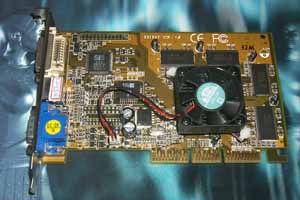   Samsung produces memory chips with 5 ns access time, which corresponds to 200 MHz. The card operates at 166/166 MHz. The design is simple, it is very similar to Riva TNT2 and GeForce2 MX cards. The distinguishing feature of the SIS 315 cards is a coprocessor - SIS 301: 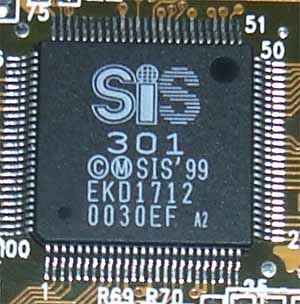 Usually it implements additional functions of the SIS 315 chipset such as screening on TV, on two CRT monitors etc. This revision can only display an image on a TV screen and on two digital monitors. The chipset is equipped with a usual cooler with a fan. Having removed it we saw the GPU itself: 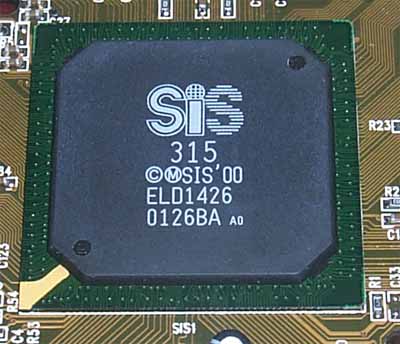  The card ships in a Retail package which contains:
OverclockingThe card has reached only 180 MHz. That is why it makes no sense to estimate a performance of the overclocked PowerColor Evil SAM. Installation and driversTest system:
During the tests we used the SiS drivers of v2.05.02. There is also a utility which can help you make some settings for the card: 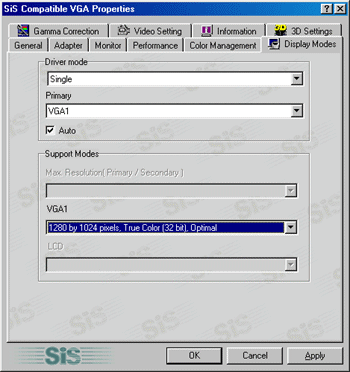  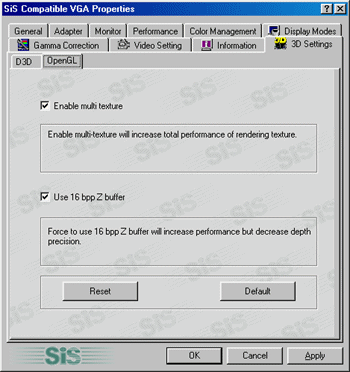 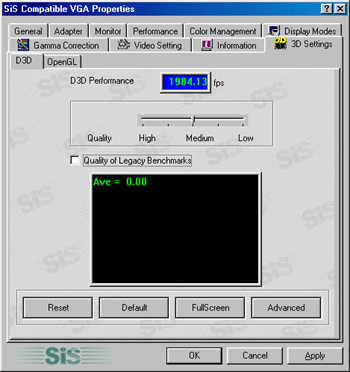 Thus, you can adjust a color balance, overlays, parameters of Direct3D/OpenGL (though they are quite scarce) etc. You can also get information on the card and its software:  The utility is available from the control panel below on the right:  For the comparative analyses we used the following cards:
Test resultsLet's start with 2D. Despite a high frequency of the RAMDAC, the image quality is good only up to 1280X1024 at 75 Hz. At higher resolutions an image becomes soapy. For estimation of 3D quality we used the Quake3 Arena v.1.17 (id Software/Activision) - a game test which demonstrates operation of a card in OpenGL with a standard demo benchmark demo002, and Giants: Citizen Kabuto (Planet Moon Studios/Digital Mayhem/Interplay) - a game test which demonstrates operation of a card in Direct3D with the gamegauge benchmark. Quake3 Arenademo002, standard modesThe tests were carried out in two modes: Fast (16-bit color) and High Quality (32-bit color).  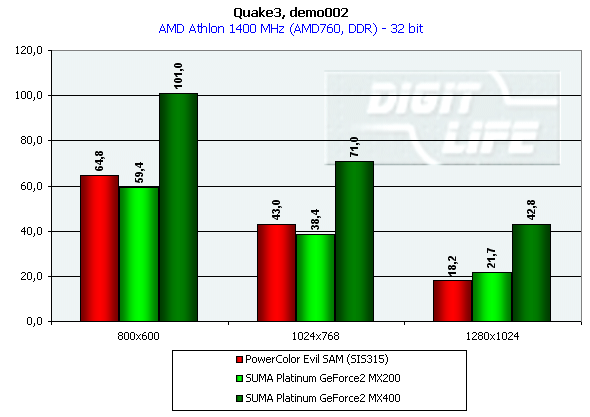 The SIS 315 card goes on a par with the GeForce2 MX200. The 128-bit bus didn't help the chip, and just two texture modules put the SIS 315 on the level of the NVIDIA TNT2 Pro/Ultra chips. demo002, highest quality modeThe tests with the demo002 were carried out in 16bit and 32-bit color modes at the highest detailing level. Objects in the scenes were divided into a huge number of polygons: r_lodCurveError "30000" r_subdivisions "1". 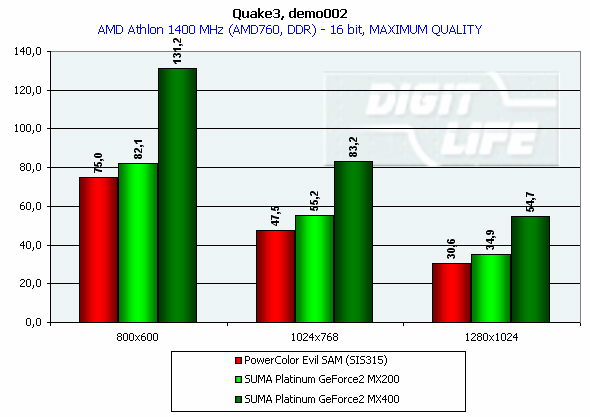 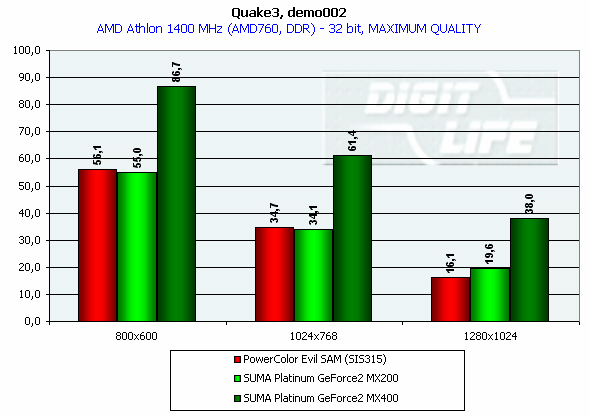 Well, the situation hasn't changed. Giants 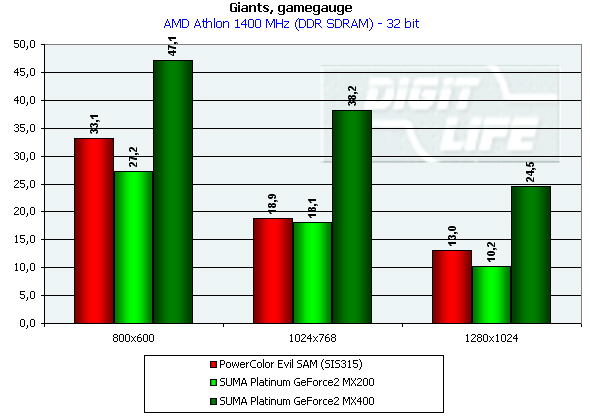 In this test at the tough load on the video chip the situation is altered. The bandwidth of the memory running at 166 MHz is not enough to realize the potential of this card. And I wish the frequencies of the chip and memory were not synchronized in the SIS 315 as the 5ns memory could have worked much faster. I'm not going to examine operation with the TV-out as the card has no any adapter for its S-Video connector. ConclusionToday we had in our lab a low-end card from SIS. It is hard to say whether it will be able to press the current cards from NVIDIA. The SIS 315 demonstrates a low performance, and its possibilities to work in 32-bit color in 3D will be hardly of great use. Moreover, the today's market offers a lot of cards on the NVIDIA TNT2/Pro/Ultra which are inexpensive and have the same productivity. Besides, there are 3dfx Voodoo3 3000 based cards which are more efficient in 16-bit color and cost some $30. However, they are not supported by NVIDIA and have some great limitations in operation with large textures. At the same time you should take into account that the SIS 315 card has the Hardware TCL unit and costs lower than the GeForce2 MX200 with such a block. Besides, the SIS 315 supports many functions absent in the TNT2 products: trilinear filtering and Dot3 Product relief texturing. Moreover, SIS updates its drivers very often, and now there are no any global problems with quality in 3D. In our 3Digest you can find thorough information on the 3D performance of cards of this and other classes. Pros:
Cons:
Write a comment below. No registration needed!
|
Platform · Video · Multimedia · Mobile · Other || About us & Privacy policy · Twitter · Facebook Copyright © Byrds Research & Publishing, Ltd., 1997–2011. All rights reserved. |